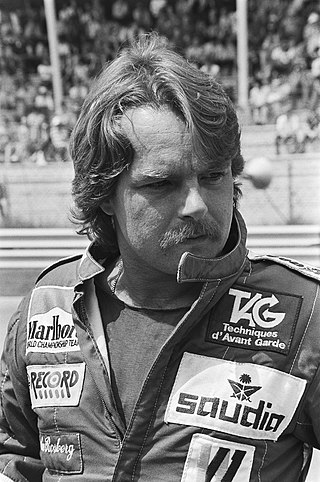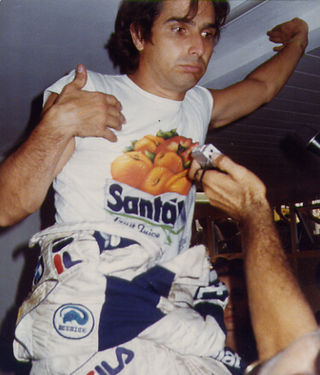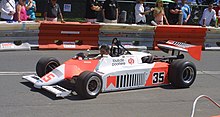
Riccardo Gabriele Patrese is an Italian former racing driver, who raced in Formula One from 1977 to 1993.

Keijo Erik Rosberg, best known as "Keke", is a Finnish former racing driver and winner of the 1982 Formula One World Championship. He was the first Finnish driver to win the championship. He is the father of Nico Rosberg, the 2016 Formula One World Champion.
Arrows Grand Prix International was a British Formula One team active from 1978 to 2002. It was known as Footwork from 1991 to 1996.

Thierry Marc Boutsen is a Belgian former racing driver who raced for the Arrows, Benetton, Williams, Ligier and Jordan teams in Formula One. He competed in 164 World Championship Grands Prix, winning three races, achieving 15 podiums and scoring 132 career points. His best finish in the World Drivers' Championship was fourth in 1988 whilst driving for Benetton. He also twice finished second in the 24 Hours of Le Mans sportscar race.

The 1985 San Marino Grand Prix was a Formula One motor race held at Imola on 5 May 1985. It was the third race of the 1985 Formula One World Championship. The 60-lap race was won by local driver Elio de Angelis, driving a Lotus-Renault, after McLaren driver Alain Prost had been disqualified for being underweight. It was de Angelis' second and last win. Thierry Boutsen was second in an Arrows-BMW, with Patrick Tambay third in a factory Renault.

The 1989 FIA Formula One World Championship was the 43rd season of FIA Formula One motor racing. It began on 26 March and ended on 5 November. Alain Prost won his third Drivers' Championship, and McLaren won the Constructors' Championship.

The 1987 FIA Formula One World Championship was the 41st season of FIA Formula One motor racing. It featured the 1987 Formula One World Championship for Drivers and the 1987 Formula One World Championship for Constructors, which were contested concurrently over a sixteen-race series that commenced on 12 April and ended on 15 November.

The 1985 FIA Formula One World Championship was the 39th season of FIA Formula One motor racing. It featured the 1985 Formula One World Championship for Drivers and the 1985 Formula One World Championship for Manufacturers, both of which commenced on 7 April and ended on 3 November after sixteen races.

The 1983 FIA Formula One World Championship was the 37th season of FIA Formula One motor racing. It featured the 1983 Formula One World Championship for Drivers and the 1983 Formula One World Championship for Manufacturers, which were contested concurrently over a fifteen-race series that commenced on 13 March and ended on 15 October.

Ivan Franco Capelli is an Italian former Formula One driver. He participated in 98 Grands Prix, debuting on 6 October 1985. He achieved three podiums, and scored a total of 31 championship points. From 1998 until 2017, he was a Formula One commentator on the Italian TV station Rai 1.

Stefan Nils Edwin Johansson is a Swedish racing driver who drove in Formula One for both Ferrari and McLaren, among other teams. Since leaving Formula One he has won the 1997 24 Hours of Le Mans and raced in a number of categories, including CART, various kinds of Sports car racing and Grand Prix Masters.
The Japanese automobile manufacturer Honda has participated in Formula One, as an engine manufacturer and team owner, for various periods since 1964. Honda's involvement in Formula One began as a full team and engine entry in the 1964 season, and in 1965 they achieved their first victory at the Mexican Grand Prix. After further success with John Surtees, Honda withdrew at the end of the 1968 season due to difficulties selling road cars in the United States and Honda driver Jo Schlesser's fatal accident.

The McLaren M23 was a Formula One racing car designed by Gordon Coppuck, with input from John Barnard, and built by the McLaren team. It was a development of the McLaren M16 Indianapolis 500 car. A Ford Cosworth DFV engine was used, which was prepared by specialist tuning company Nicholson-McLaren Engines. This helped push the DFV's horsepower output to around 490 bhp.

Footwork Arrows was a British Formula One motor racing team which competed from 1991 to 1996. Japanese businessman Wataru Ohashi, who was the president of Footwork Express Co., Ltd., a Japanese logistics company, began investing heavily in the Arrows team in 1990, the deal including requiring the cars to display the Footwork logo prominently. The team was officially renamed Footwork in 1991, and secured a deal to race with Porsche engines. Results were poorer than expected, and after just six races, Footwork dropped the Porsche engines and continued with Hart-built Ford engines.
The Zakspeed 861 was a Formula One car designed by Paul Brown for the Zakspeed team and was used in both the 1986 and 1987 seasons. In 1986 its drivers were Jonathan Palmer and Huub Rothengatter. The team did not employ a test driver as they could not afford one, despite sponsorship from German tobacco brand West. The lack of money also meant that the car's engine, Zakspeed's own 4 cylinder 1500/4 turbocharged power unit, which was rated at about 850 bhp for the season, was also short on power and development compared to those at the front of the grid. The team used Goodyear tyres.

The Williams FW09 was a Formula One car designed by Frank Dernie and Neil Oatley. It was the first Williams chassis to be powered by a turbocharged Honda V6 engine, for which Frank Williams negotiated a deal towards the end of 1982 and the beginning of 1983.

The Spirit 201 was a Formula One and Formula Two racing car designed by John Baldwin and Spirit Racing co-founder Gordon Coppuck which was raced in European Formula Two from 1982 to 1984 and in Formula One in 1983.

The Spirit 101 was a Formula One car for the 1984 and 1985 Formula One seasons. The car was designed by Gordon Coppuck and Tim Wright.

The Honda RA16 engine is a highly-successful and extremely powerful, turbocharged, 1.5-litre, 80-degree, V-6 racing engine, designed for use in Formula One; between 1983 and 1988. The customer engines were used by Spirit, Williams, Lotus, and McLaren.
The Honda RA260E is a four-stroke, naturally-aspirated, 2.0-liter, V6 racing engine, designed for Formula 2, which was built and developed by Honda Motor Co., Ltd, for Formula 2 racing, in 1980.















